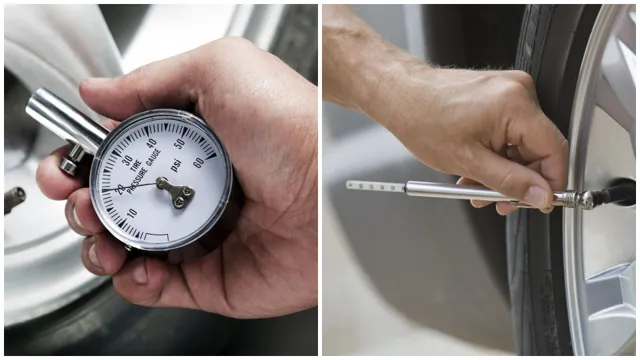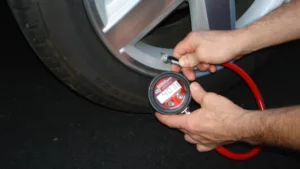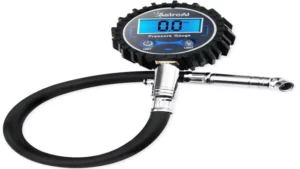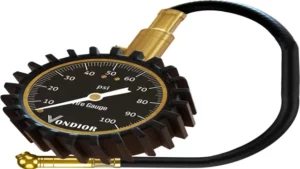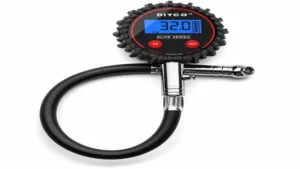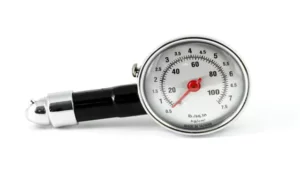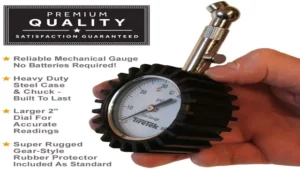Have you ever wondered if your tire pressure gauge is telling you the truth about your tires? There’s nothing worse than having an inaccurate gauge that causes you to overinflate or underinflate your tires, leading to potentially dangerous driving situations. Luckily, checking the accuracy of your tire pressure gauge can be done easily and quickly. In this blog post, we’ll show you different methods to test your tire pressure gauge for accuracy and ensure your tires are always properly inflated.
So, let’s jump right in!
Introduction
Checking the accuracy of your tire pressure gauge is an important aspect of maintaining your vehicle’s safety and performance. A tire pressure gauge that is not calibrated correctly can give inaccurate readings, leading to underinflated or overinflated tires, which can cause tire wear, poor handling, and even accidents. To check the accuracy of your tire pressure gauge, you can use an accurate gauge to compare readings.
Simply remove the valve cap, press the gauge evenly onto the valve stem, and wait for the reading to stabilize before taking note of it. Repeat the process with the second gauge, ensuring that both gauges are calibrated to the same standard. If there is any significant difference between the readings, it may be time to replace your tire pressure gauge or have it calibrated by a professional.
Regular checks of your tire pressure gauge can help to ensure that your tires are always at the right pressure, maximizing safety and performance on the road.
Why is it Important to Check Tire Pressure?
Checking tire pressure is an important aspect of vehicle maintenance that many of us tend to overlook. In fact, it is often considered a hassle, and many drivers only do it when they notice a problem. However, maintaining the correct tire pressure is crucial to ensure driving safety, prolong tire life, and improve your vehicle’s fuel efficiency.
Low tire pressure can lead to a flat tire, but even slightly low pressure can cause uneven tread wear, and in turn, decreased handling and stability on the road. On the other hand, overinflated tires can result in a bumpy ride and reduced tire grip, which is especially dangerous in wet or slippery conditions. Therefore, it is essential to check your tire pressure regularly, preferably once a month, to avoid any potential problems and keep you and your passengers safe on the road.
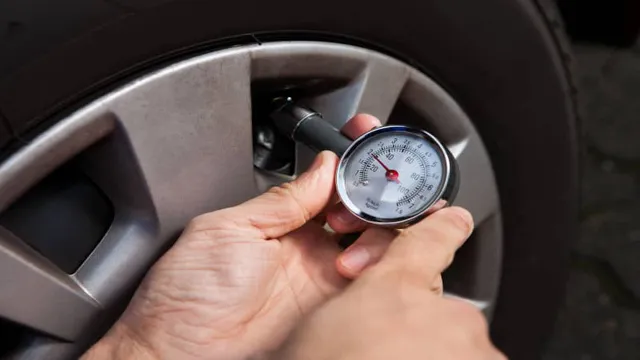
Types of Tire Pressure Gauges
When it comes to checking the accuracy of your tire pressure gauge, it’s important to consider the type of gauge you have. There are three main types of tire pressure gauges: digital, analog, and dial. Digital gauges are considered the most accurate, as they provide a precise reading.
Analog gauges, on the other hand, can be a bit less accurate, as they require the user to read the gauge manually and often have a larger margin of error. Dial gauges fall somewhere in between, with a needle that points to the tire pressure measurement. Regardless of the type of gauge you’re using, it’s important to keep it calibrated and maintained regularly to ensure its accuracy.
This means checking it against other gauges or a professional mechanic’s gauge. By staying on top of your tire pressure gauge’s accuracy, you can ensure your tires are always properly inflated, leading to better fuel economy, improved safety, and longer tire life.
Analog Tire Pressure Gauge
When it comes to tire pressure gauges, there are a few different types to choose from. One of the most popular options is the analog tire pressure gauge. These gauges are relatively simple in design, with a small, handheld tool that has a probe or nozzle on one end.
To use an analog gauge, you simply insert the probe into the tire’s valve stem and the gauge provides a reading of the internal pressure. Analog tire pressure gauges are often praised for their simplicity and affordability. Because they don’t rely on any electronic components, they tend to be very durable and have a long lifespan.
Additionally, they can often be quite accurate, though this can depend on the quality of the gauge and the user’s ability to read it properly. One downside of analog gauges is that they can be a bit more difficult to read than digital models, which provide a numeric readout on an LCD screen. Analog gauges typically display pressure readings on a dial that can be a bit harder to interpret, especially for those who are not familiar with the gauge.
Additionally, analog gauges can be more prone to inaccuracies due to changes in atmospheric pressure or other external factors. Overall, analog tire pressure gauges are a reliable and affordable choice for those who need to check their tire pressure regularly. While they may not offer the same level of precision as some digital models, they can still provide accurate readings with a bit of practice.
Whether you’re a seasoned driver or a novice, an analog tire pressure gauge is a useful tool to have on hand.
Digital Tire Pressure Gauge
Digital Tire Pressure Gauge When it comes to maintaining the health of your car, checking tire pressure on a regular basis is essential. This is where tire pressure gauges come in handy. There are several types of tire pressure gauges available today, each with its own advantages and disadvantages.
The most common types are pencil gauges, dial gauges, and digital gauges. Pencil gauges are the most affordable but not as accurate as the others. Dial gauges are easy to use and provides precise pressure readings, but they can be a bit bulky and breakable.
On the other hand, digital gauges are the most accurate and can be compact enough to fit in your glove compartment. They have clear LCD displays and can also give readings in different units. Overall, digital tire pressure gauges are the most convenient and easiest to use.
They may be slightly more expensive, but for the accuracy and conveniences they offer, they are definitely the way to go.
Methods to Check Accuracy of Tire Pressure Gauge
If you want to ensure the accuracy of your tire pressure gauge, there are a few methods you can try out. First, you can compare your gauge’s readings with those of another gauge or the pressure gauges at a gas station. Make sure to check the pressure when the tire is cold as a hot tire can give a false reading.
Another method is to use a bulb or handheld pressure calibrator to test your gauge’s accuracy by comparing its reading to a known accurate reading. Additionally, you can try testing your gauge against a professional calibrated gauge. It’s important for your tire pressure gauge to be accurate as too much or too little air in your tires can lead to poor fuel efficiency, handling issues, and even blowouts.
So, take the time to check the accuracy of your gauge so you can drive safely and confidently.
Using a Tire Pressure Gauge Tester
Tire Pressure Gauge Tester Maintaining the proper tire pressure is crucial for the longevity of your vehicle. A tire pressure gauge is a handy device that checks if your tires are inflated appropriately. However, did you know that these gauges need calibration to ensure their accuracy? Here are some methods to check the accuracy of your tire pressure gauge tester.
First, test it against a calibrated gauge to compare the readings. Second, check it with your vehicle manufacturer’s recommended tire pressure specifications. Third, you can check it using an air pressure gauge to ensure you get consistent measurements.
Regularly checking your tire pressure gauge accuracy ensures optimal tire pressure levels and vehicle safety. Have you ever calibrated your tire pressure gauge tester? Why not give it a try and see if you can get more accurate readings?
Using an Air Compressor Gauge
If you want to ensure that your vehicle’s tire pressure gauge is accurate, there are several methods you can use to check it. One of the most popular ways is to utilize an air compressor gauge, which works by measuring the tire’s air pressure with a small dial or digital display. To check the accuracy of your tire pressure gauge, begin by removing the valve cap from the tire and pressing the air compressor gauge tightly against the valve.
Hold it there for a few seconds to allow the gauge to register the pressure, and take note of the reading. Then, compare that reading to the recommended pressure listed in your vehicle owner’s manual. If the reading is off by more than 1 or 2 PSI, you may need to calibrate or replace your gauge.
By using an air compressor gauge and following these simple steps, you can ensure that your vehicle’s tire pressure is properly maintained and that you’re always driving on safe, reliable tires.
Comparing Readings from Different Gauges
When it comes to maintaining our vehicles, checking tire pressure is a crucial task. Using gauges is the most common way to determine the correct tire pressure. But, what if the readings from different gauges don’t match? Checking the accuracy of tire pressure gauges is essential for keeping our tires in good condition and ensuring our safety on the road.
One of the most straightforward ways to check the accuracy of a tire pressure gauge at home is to compare it with another gauge. You can use a digital or analog gauge and compare its reading with other gauges. It is best to use gauges that have been calibrated to know the margin of error.
By checking the readings of different gauges, you can identify the accuracy of your gauge and ensure optimum tire pressure. As an analogy, think of gauges as rulers. Like rulers, gauges can be different, and some may be more accurate than others.
By comparing readings, you can be confident that you’re getting the right measurement.
Tips for Accurately Checking Tire Pressure
It is essential to check the accuracy of your tire pressure gauge regularly. One way to do this is to test it against a calibrated gauge, which can be found at most automotive shops. When checking the pressure of your tires, make sure they are cold and have not been driven for at least a few hours.
Insert the gauge into the valve stem and press down until the hissing sound stops. Check the reading on the gauge and compare it to the recommended pressure listed in your owner’s manual or on the tire itself. If the gauge readings are consistently inaccurate, it may be time to replace it.
Remember, maintaining proper tire pressure can increase fuel efficiency, help prevent blowouts, and improve overall handling and safety. So, take the time to check your tire pressure regularly to ensure maximum performance and safety.
Check Tire Pressure When Tires are Cold
Checking tire pressure regularly is crucial to ensure optimal driving safety and performance. One important tip to keep in mind is to always check tire pressure when the tires are cold. Why? When tires are hot, the air pressure inside them increases due to the heat created by driving.
This means that if you check tire pressure after driving, you may get inaccurate readings that could lead to underinflation or overinflation. To get an accurate reading, make sure your car has been sitting for at least three hours before checking the tire pressure. Use a reliable pressure gauge and check the pressure of all four tires, including the spare tire if you have one.
Keep in mind that the recommended tire pressure levels may vary depending on the make and model of your car, so always consult your owner’s manual or ask a qualified mechanic for advice. By following these tips and checking tire pressure regularly, you can enjoy a smoother, safer driving experience while also saving money on fuel and tire replacements in the long run.
Check Tire Pressure at Least Once a Month
Checking your tire pressure at least once a month is an essential task to ensure that your car is safe to drive. Low tire pressure can affect your car’s handling and fuel economy, while overinflated tires can lead to a rough ride, reduced traction, and increased wear and tear. Fortunately, checking your tire pressure is an easy and straightforward task that can be done in a matter of minutes.
Some tips to ensure accuracy include using a reliable tire gauge, checking your tire pressure when your tires are cold, and referencing your car’s manual or the tire pressure label on the driver’s side door jamb for the appropriate pressure. The optimal time for checking your tire pressure is in the morning before you begin driving, as your tires may have lost some pressure overnight. Regular tire pressure checks can save you money on fuel and prevent accidents, so don’t neglect this crucial maintenance task.
Conclusion
In conclusion, checking the accuracy of your tire pressure gauge is just as important as checking the pressure itself. Don’t let a faulty gauge deflate your confidence in your tire pressure. To ensure accuracy, use a trusted calibration method like the penny test or seek the advice of a professional.
Remember, a little effort upfront can prevent a flat-out disaster on the road. So test those gauges, folks, and keep your wheels turning smoothly!”
FAQs
What is a tire pressure gauge and how does it work?
A tire pressure gauge is a tool used to measure the air pressure in a tire. It typically has a small rod that presses down on a valve stem on the tire to give a reading. The gauge is accurate when it is calibrated correctly and used properly.
How often should I check the tire pressure in my car?
It is recommended to check the tire pressure in your car at least once a month or before long road trips.
Can using an inaccurate tire pressure gauge cause problems to my vehicle?
Yes, using an inaccurate tire pressure gauge can lead to over-inflation or under-inflation of your tires which can cause uneven tire wear, poor fuel efficiency, and even a blowout on the road.
How do I calibrate my tire pressure gauge?
To calibrate your tire pressure gauge, you can use a known accurate gauge and compare the readings. If your gauge is not accurate, there may be an adjustment screw or nut on the gauge that can be turned to correct it.
Is it necessary to use a specific type of tire pressure gauge for my vehicle’s tires?
It is recommended to use a gauge that is appropriate for the type of tires on your vehicle. For example, a gauge designed for cars may not be suitable for trucks or motorcycles.
Should I adjust the tire pressure after using the gauge for accuracy?
Yes, if your tire pressure gauge is showing a different reading than what is recommended for your vehicle, you should adjust the pressure accordingly.
Are digital tire pressure gauges more accurate than analog ones?
Digital tire pressure gauges are generally considered to be more accurate than analog ones, as they are less prone to mechanical error and can give readings to a greater level of precision.
